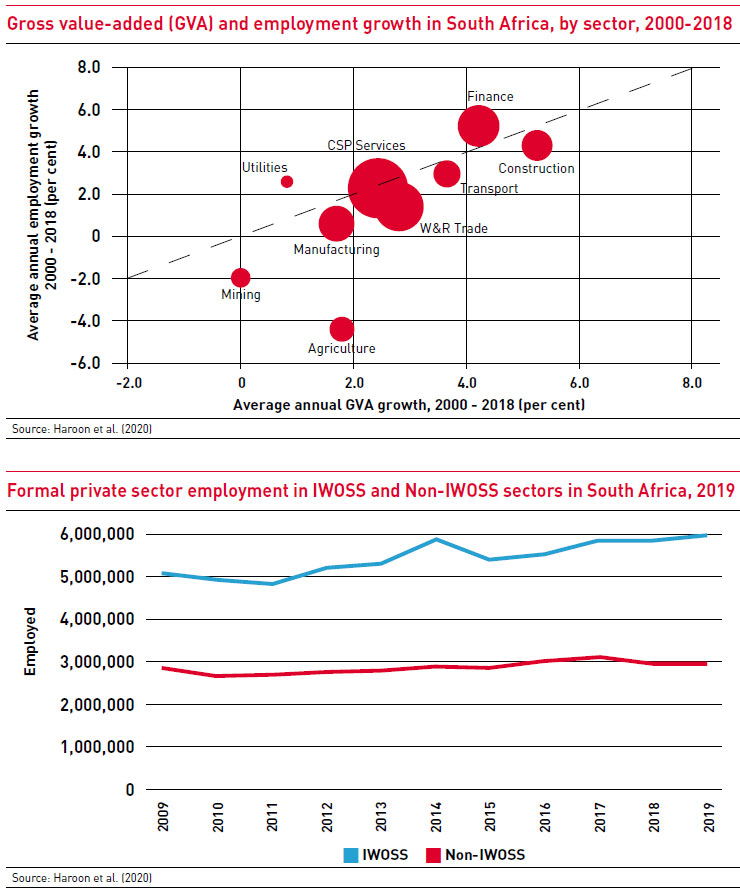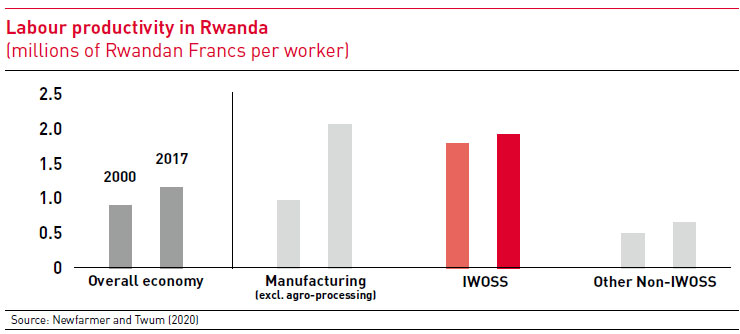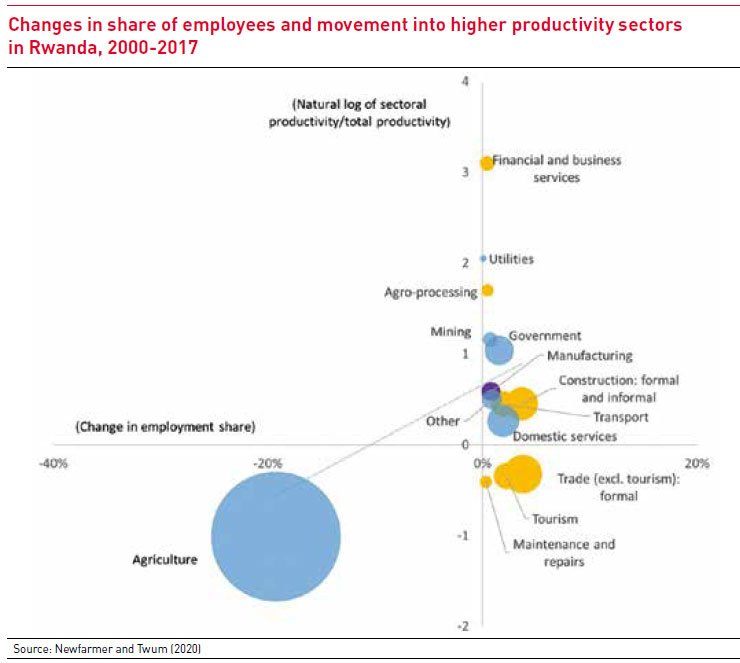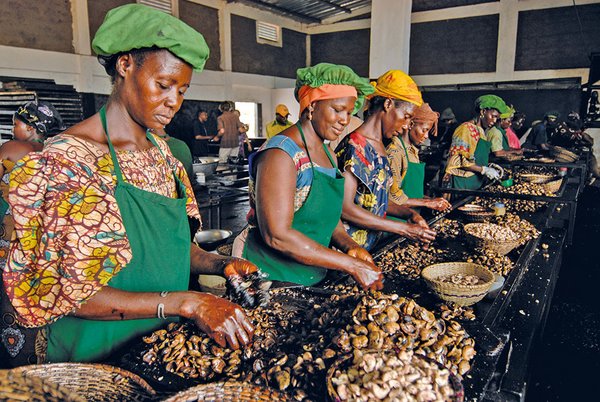 Download this article in magazine layout
Download this article in magazine layout
- Share this article
- Subscribe to our newsletter
Leveraging the employment potential of industries without smokestacks
Economists have long regarded economic transformation – the movement of workers from lower to higher productivity employment – as essential to successful economic development. Traditionally, the development of export-oriented industries, notably manufacturing, has been a key driver of structural transformation. Since the first Industrial Revolution in the 18th century, manufacturing has helped transform most of today’s advanced and richest economies and, more recently, has been the catalyst of the East Asian Miracle. In these economies, large numbers of workers leaving agriculture moved into manufacturing, driving growth, job creation and poverty reduction. However, evidence is emerging that manufacturing-led development is losing its effectiveness.
In 2015, Harvard economist Dani Rodrick documented a global pattern of premature deindustrialisation – in other words, declining peak shares of output and employment at lower levels of income – in recent decades. For example, whereas manufacturing could absorb 30 per cent or more of labour for early industrialisers such as Great Britain or Sweden, now its share of labour is peaking at around 15 per cent or less in many emerging market and developing countries. Across Africa, manufacturing as a share of total economic activity has stagnated at around 10 per cent, with economic activity moving from agriculture to low-productivity services instead.
This global pattern of premature deindustrialisation suggests that manufacturing-led growth may no longer serve as a viable development model for current low-income countries. In this context, new research by the Brookings Institution’s Africa Growth Initiative finds a promising alternative path towards economic transformation based on tradable services. These tradable services or “industries without smokestacks” (IWOSS) include subsectors like tourism, horticulture, agro-processing and certain ICT-based services.
Three salient features of manufacturing made it an effective development escalator. First, manufacturing goods are tradable, which provides possibilities for countries to scale up production beyond the consumption capacity of local economies, thus boosting national income. Second, manufacturing benefits from technological transfers, which allows productivity of local production to converge with that of global production. Third, importantly, manufacturing absorbs large numbers of moderately skilled labour at a productivity premium, delivering sustained aggregate productivity gains and driving structural economic transformation.
Within its research project, the Africa Growth Initiative has identified an emerging, novel pattern of structural change in Africa based on industries without smokestacks. Indeed, these sectors are outpacing manufacturing in many countries. Between 1998 and 2015, services exports grew more than six times faster than merchandise exports. Kenya, Rwanda, Senegal and South Africa have vibrant ICT-based services sectors. Tourism is Rwanda’s largest single export activity, accounting for about 30 per cent of total exports, and provides 14 per cent of GDP in Tanzania. In 2014, 9.5 million tourists visited South Africa, contributing 3 per cent to its GDP. Ethiopia, Ghana, Kenya and Senegal all actively participate in global horticultural value chains. Ethiopia has achieved extraordinary success in flower exports, so much so that the country is now a global player in the sector. Industries without smokestacks are also relatively more labour intensive.
Leveraging IWOSS to address the employment challenge
While premature deindustrialisation is a global phenomenon not unique to Africa, the process will be more consequential for the continent, given the scale of the demographic and employment challenges. By some estimates, Africa’s working-age population will grow by approximately 450 million people – about 3 per cent per annum – between 2015 and 2035. By 2050, Africa will have 362 million young people between the ages of 15 and 24 years. Where will the region find the productive jobs for such a rapidly growing, young population in the context of premature deindustrialisation? The ability to move large numbers of workers from lower to higher productivity activities will boost overall aggregate productivity and deliver structural transformation. The Africa Growth Initiative is conducting a research programme to assess the employment creation potential of industries without smokestacks in ten countries across Africa. The preliminary results, which are available for Rwanda and South Africa, show that IWOSS have an encouragingly high employment potential.
The case of South Africa
Economic growth in South Africa has remained very low since 1994, averaging just 2.7 per cent. The country’s youth unemployment rate – at close to 55 per cent in 2018 – is considerably higher than in comparable upper-middle-income countries or other countries in sub-Saharan Africa. Moreover, both overall unemployment and youth unemployment have shown an upward trend over the past ten years or so. In short, like in many countries across Africa, South Africa’s current growth path has failed to provide enough jobs for the low-skilled unemployed.
The post-1994 South African economy has been characterised by an eroding primary sector and a stagnant manufacturing sector – both concerning trends (see Figure below). At the same time, there has been a shift towards services sectors, with finance, transport, construction and other services experiencing modest employment growth. Notably, the financial and community services sectors have accounted for over half of the increase in employment between 2000 and 2019. In short, while the shift to services may offer South Africa an opportunity for the type of structural transformation previously anchored by growth in manufacturing, this achievement depends, importantly, on the type of services. The lower Figure shows the evolution of employment in IWOSS and non-IWOSS sectors. Out of 8.9 million formal private sector jobs in South Africa in 2019, IWOSS sectors account for over two thirds (68 per cent), more than double the share of non-IWOSS sectors.

In the face of premature deindustrialisation, South Africa already appears to be on a path of structural transformation characterised by a shift toward IWOSS. Industries without smokestacks, notably agro-processing, horticulture and tourism, are all intensive in low- and semi-skilled labour; in fact, about 90 per cent of total employment in these sectors can be characterised in such a way. Thus, these sectors have the potential to generate employment for the low-skilled labour force on a large scale, if the operating scale of these sectors can be increased. Indeed, early projections indicate that, annually and on average, around 3.4 times more jobs are to be created in IWOSS sectors in comparison to non-IWOSS sectors, and that IWOSS will account for nearly 80 per cent of all new jobs through 2028.
The case of Rwanda
In contrast to South Africa’s economy, that of Rwanda has expanded rapidly, at an impressive eight per cent annually since 2000. However, like South Africa, Rwanda’s economic transformation has involved the movement of workers into progressively higher-productivity industries without smokestacks. As shown in the Figure, labour productivity, defined as value-added per worker, is comparable to that of manufacturing and twice as high as productivity in the overall economy. As such, the movement of labour into IWOSS sectors is occurring at a productivity premium that is boosting aggregate productivity and overall economic transformation.
Between 2000 and 2017, employment growth in IWOSS averaged nine per cent, three times higher than in the rest of the economy. Notably, employment in key IWOSS sectors such as agro-processing and tourism expanded at double-digit rates. By 2035, IWOSS are projected to generate nearly 70 per cent of new employment in Rwanda.


Shared characteristics allow two-tier development
As the preliminary results for South Africa and Rwanda illustrate, industries without smokestacks are tradable services with the potential to support structural transformation in low-income countries given their shared characteristics with traditional manufacturing. Like manufacturing, apart from being tradable, they benefit from technological innovation, and, very importantly, they are intensive in low- and semi-skilled labour. IWOSS sectors also benefit from agglomeration, including information and knowledge spill-overs. Most low-income countries often focus on developing special economic zones (SEZs) to promote manufacturing. SEZs are relevant to IWOSS sectors such as agro-based industries as well. The enabling environment that supports the development of manufacturing, including an adequate investment climate, capacity to export and agglomeration, is like that for industries without smokestacks. While economists have been increasingly confident that development models for today’s low-income countries, notably those in Africa, will be different from that of East Asia, they have been less certain about what shape these will take. The industries without smokestacks model offers an answer. Because manufacturing and IWOSS have similar characteristics and enabling environment, from a public policy perspective, it is happily not a choice between manufacturing and IWOSS. Policy-makers can develop industries without smokestacks alongside efforts to develop those with smokestacks, thus offering a multifaceted approach to achieve structural transformation and overall economic development.
Brahima S. Coulibaly is a Senior Fellow and Director of the Africa Growth Initiative at the Brookings Institution, Washington, D.C., USA.
He holds a PhD in Economics from the University of Michigan.
Contact: bcoulibaly@brookings.edu
References and further reading
- Allen Caitlin, Zaakhir Asmal, Haroon Bhorat, Robert Hill, Jabulile Monnakgotla, Morné Oosthuizen and Christopher Rooney: “Addressing Africa’s Youth Unemployment through Industries without smokestacks: The case of South Africa” forthcoming, Africa Growth Initiative Brookings-DPRU mimeo.
- Asmal Zaakhir, Bhorat, Haroon, and John Page: “Exploring new sources of large-scale job creation: The potential role of Industries Without Smokestacks”, Foresight Africa 2020, Africa Growth Initiative, Brookings Institution.
- Coulibaly, Brahima: “Africa’s Alternative Path to development”, Project Syndicate, May 2018.
- Newfarmer Richard and Anna Twum: “Addressing Africa’s Youth Unemployment through Industries without smokestacks: The case of Rwanda”, forthcoming, Africa Growth Initiative Brookings-International Growth Center Rwanda mimeo.
- Newfarmer Richard, John Page, Finn Tarp: “Industries without smokestacks: Industrialization in Africa Reconsidered”, Africa Growth Initiative and UNU-WIDER, Oxford University Press.
- Page, John: “Rethinking Africa’s structural transformation: The rise of new industries”, Foresight Africa 2018, Africa Growth Initiative, Brookings Institution.
The results for the Rwanda and South Africa case studies, joint with IGC-Rwanda and DPRU-South Africa, are forthcoming.





Add a comment
Be the First to Comment